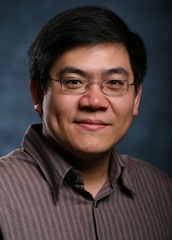Two more junior faculty members at the University of Houston’s Cullen College of Engineering have received National Science Foundation (NSF) Faculty Early Career Development (CAREER) Awards.
The NSF CAREER grants to Jacinta Conrad and Wei-Chuan Shih boost the total this year to five for Cullen and seven overall for UH, the most awarded in one year to the college as well as the university.
NSF CAREER Awards are among the most prestigious grants awarded in the science, technology, engineering and mathematics (STEM) fields. They are awarded to exemplary junior-level faculty members to help them launch long-term, successful research careers.
Conrad, assistant professor of chemical and biomolecular engineering, received a five-year, $400,000 grant to develop surfaces that limit bacterial movement.
Shih, assistant professor in electrical and computer engineering, won a five-year, $400,000 grant to develop a new method to rapidly identify, count and profile bacteria.
Cullen’s other NSF CAREER award winners this year are Jiming Bao, Debora Rodrigues and Gila Stein. UH’s College of Natural Sciences and Mathematics also had two winners this year: Angela Moeller and Ognjen Miljanic, both assistant professors of chemistry.
Conrad is studying how bacteria movement influences the formation of biofilms, colonies of bacteria that are extremely difficult to remove once they have formed.
Biofilms that form in oil and water pipelines foul the liquids flowing through them and they are cited as a significant source of drag on marine vessels. In hospitals, biofilms are implicated in up to 80 percent of all non-specific infections.
Over the past 18 months,
Conrad and her collaborators have published two articles, one in Science and
the other in the Proceedings of the National Academy of Sciences, revealing new
methods of bacteria motility, or movement.
Conrad plans to use this new understanding of bacteria motility to design surfaces that can inhibit biofilm formation and change the shapes these biofilms take.
Conrad said an advantage to her approach is that it would be inexpensive compared to other technologies currently being developed, making it ideal for covering large spaces like the inside of pipelines or the hulls of marine vessels.
“We’re looking for large-area strategies, coatings that you could just paint on, for example. You’re not going to cover a whole wall with an engineered biomolecule because that would be too expensive. But maybe you’ll apply a coating that inhibits biofilm formation and makes it easy to scrape it off,” she said.
Shih’s research work on developing a new method to rapidly identify, count and profile bacteria would be useful in medical diagnostics, national security and food and environmental safety.
At the heart of the new method
is Raman microspectroscopy, a technique of “fingerprinting” molecules by
shining laser light on them. Exactly how a molecule causes the laser’s incident
photons to scatter, as evidenced by a change in color, can be used for
identification purposes.
Traditional Raman microspectroscopy, however, examines only one small point at a time. As a result, imaging just a square millimeter can take several hours or longer, making it impractical outside the laboratory setting.
Shih is working to speed this process by combining two different Raman microspectroscopy techniques – including one that uses nanotechnology – with novel instrumentation and integrated computational image analysis.
Although identifying specific bacteria types is the ultimate goal, it’s likely that simply detecting the presence of bacteria can be useful, he noted.
“In many cases, doctors just want a ‘yes’ or ‘no’ answer. They’re not looking to identify the bacteria, they just want to know if they are present,” Shih said. “If we can answer that question quickly and efficiently, there’s a real possibility that we could develop a system that is applicable to a clinical setting.”

